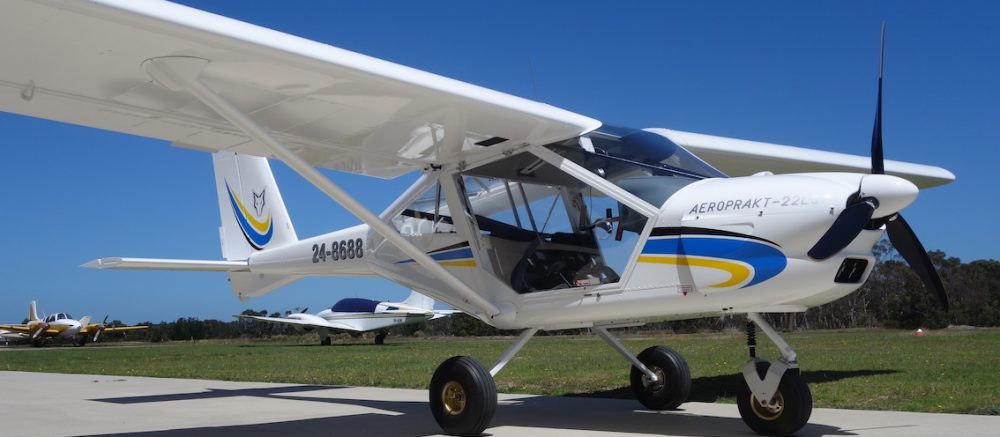[Please note – many subscribers have reported that the embedded videos in this post did not work correctly. I have replaced them with links to the YouTube versions, so they now work as usual. Please click the picture to go to the YouTube video – view in hi-res if possible]
I have now spent over 4 hours flying the new Aeroprakt A32, initially on my own and then with four different passengers/co-pilots. I can confirm the aircraft really does have a speed range from stall at 27 knots with flap (actually almost zero knots indicated) right up to flat-out straight and level at 120+ knots at 5,500 rpm.
Skeptical? Yes, at first I was too, even though these speeds were demonstrated to me when I flew in the prototype in Kiev late last year. There has clearly been a great deal of work done on the aerodynamics to achieve these real-world figures, while retaining the sweet slow-speed handling of other Aeroprakt aircraft like the A22 and, for that matter, the A20 before that.
Here is a video of the A32 stalling, with full flap, two people on board and about 70 litres of fuel – total weight around 560 kgs. The ASI is just about centre of the frame.

Although it is natural to think the A32 is just a revamped version of the A22LS Foxbat, an important point I must make quite clear is that the A32 is fundamentally a different aircraft. I realise comparisons between the A22 and A32 are inevitable, but the only common elements between them are the engine, propeller and the wing, and even this has received a few tweaks for the A32. From and including the propeller spinner, right back to the tail, the fuselage is all-new. There are no flat panels on it – no mean feat in an all-metal aircraft – which remove ‘oil-canning’ and reduce drag and wind noise. The engine installation is completely different from the A22, with air ducting to smooth airflow, reduce drag and improve cooling. The oil radiator is mounted behind the coolant radiator, so there’s no need for an oil thermostat to speed up the warm-up.
The control system is all cable (like the iconic Piper Cub) and the all-flying tailplane is powerful and well-geared – particularly useful during landing, where even at 30 knots indicated, you don’t run out of elevator. Trim changes between take-off, cruise and landing are much smaller than on the A22 and it is easier to adjust the manual trim lever quickly to the required setting.
The cabin is actually a bit narrower at the elbow than the A22 (although it takes a ruler to confirm it) but is taller and the panoramic view through the windshield gives an impression the cabin is actually wider than the A22. The windows behind the seats are well-positioned to give a great view out. And there are plenty of storage pockets around the cabin for all those odds and ends so necessary to us pilots.

A32 cruise around 4,800 rpm. Click pic for full size
Here are a few more numbers: cruise speed at 4,800 rpm (Rotax’s recommended minimum continuous rpm) is around 107-109 knots true, burning about 16 litres an hour. To cruise at 100 knots, you’ll need to drop the rpm to around 4,200, for a fuel burn of about 14-15 litres an hour. Approach speed down finals with flap should be no faster than 50 knots, with a maximum – even two-up – of 45 knots indicated over the keys. Even then, there’s a little bit of float, so I’ll be gently pulling the speed down a bit further. After all, a reasonable rule of thumb for a very light aircraft is to approach at 1.5 times stall speed; so 1.5 x 27 gives 40.5 knots, well below the 45 kts I have been using. And that’s at maximum weight….
Here is another video, this one showing A32 cruise speeds. The SkyView screen shows, on the left side, top to bottom, indicated airspeed (IAS), true airspeed (TAS) and ground speed (GS) so you can see the differences. RPM is top centre. Sorry this one is a bit blurred and shaky, the winds aloft were quite strong and bumpy that day – close to 30-35 knots and occasionally more. Also, it turns out the Garmin VIRB camera I used is not as good at close focus as my trusty old GoPro, which was used a day later for the video showing stalls.

Where the A22LS Foxbat is a great ab-initio trainer and go-anywhere farmer’s aircraft, the A32 feels like it is much more of a sport cross-country aircraft and intermediate trainer. Speed management is particularly important in this aircraft – if you’re used to floating a bit due to overspeed when landing the A22LS Foxbat, you’ll run out of runway before the A32 stops flying – you’d better believe it!
Experienced A22LS Foxbat pilots will quickly see and feel the differences in the A32 – it’s a great addition to the Aeroprakt range.
We’re working on some more videos to show the aircraft flying, both inside the cabin as well as external sequences. Meanwhile, at least a couple of Australian aviation magazines are doing full flight tests for publication later in the year – I’ll announce when and where as soon as I have confirmation.
 Aeroprakt has issued a Letter of Approval (LOA) to mount GoPro, Garmin VIRB and other similar miniature cameras externally on A22LS Foxbat and A32 Vixxen aircraft.
Aeroprakt has issued a Letter of Approval (LOA) to mount GoPro, Garmin VIRB and other similar miniature cameras externally on A22LS Foxbat and A32 Vixxen aircraft.




